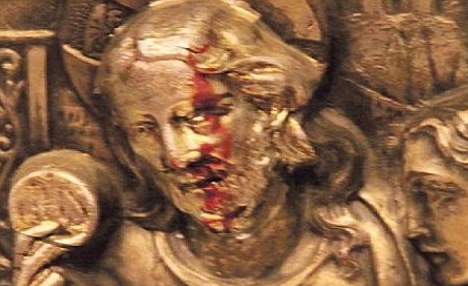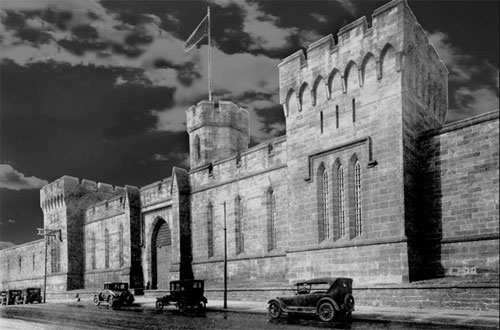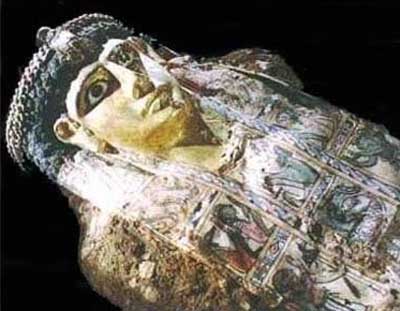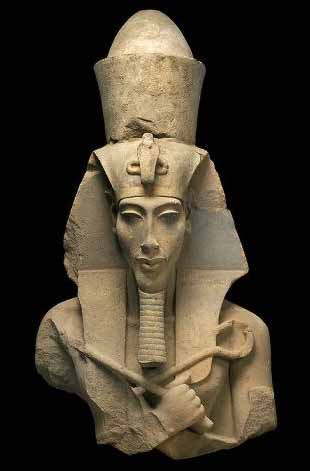A group of researchers affiliated with legendary Big Foot Hunter Tom Biscardi left North Carolina Sunday after spending Saturday night camped out in the woods near Highway 18, south of Morganton, to investigate a recent footprint sighting.
The researchers set up cameras but said they didn’t find anything. They told Eyewitness News that they will evaluate what they do have and determine if they will return to look again. Group members said they believe the footprint, which was discovered by a farmer, is real because it shows dermal ridges like a hand print and a mid tarsal break, which is evidence of a foot that bends in the middle, unlike that of a human.
Robert Price was in Hickory with two other Alabama researchers to compare a track found recently in Burke County to one found in Texas.
“The possibility is definitely there," he said. "It's not to be overlooked."
The large, muddy and mysterious footprint has captured imaginations in the area.
A farmer said he recently stumbled across a larger-than-life footprint near the intersection of Highway 18 and George Hildebran School Road in the southern part of Burke County. Pork Lowman said he was walking in the woods when he came across the print, which measures 15 by 8 inches.
“It's out here in no-man's land, and that's what really got me,” Lowman said.
Read more at http://theunexplainedmysteries.com/bigfoot-foot-prints.html
Wednesday, June 23, 2010
'Blood' runs from image of Christ
Thousands of pilgrims have overwhelmed a small church in Argentina after blood was said to be oozing down the face of an image of Jesus Christ.
A red substance was photographed running from the forehead of Jesus and down his cheek in a church depiction of the Last Supper.
Local priest Father Jorge Gandur said the 'ooze comes from one of the wounds on the left side of the forehead of Christ produced by the crown of thorns'.
The stains were first noticed on Friday by two men who had entered the Oratory of the Sacred Heart of Jesus in Yerba Buena, Tucuman province.
The pair reported the substance to Father Gandur, who took samples of the substance to be scientifically tested to see if it was human blood.
After local media were tipped off that the men had seen Christ weeping 'tears of blood' the streets surrounding the church became jammed pilgrims wanting to see the phenomenon for themselves.
More at http://theunexplainedmysteries.com/jesus-christ-blood.html
A red substance was photographed running from the forehead of Jesus and down his cheek in a church depiction of the Last Supper.
Local priest Father Jorge Gandur said the 'ooze comes from one of the wounds on the left side of the forehead of Christ produced by the crown of thorns'.
The stains were first noticed on Friday by two men who had entered the Oratory of the Sacred Heart of Jesus in Yerba Buena, Tucuman province.
The pair reported the substance to Father Gandur, who took samples of the substance to be scientifically tested to see if it was human blood.
After local media were tipped off that the men had seen Christ weeping 'tears of blood' the streets surrounding the church became jammed pilgrims wanting to see the phenomenon for themselves.
More at http://theunexplainedmysteries.com/jesus-christ-blood.html
Labels:
bizarre,
blood of christ,
christ,
jesus mysteries,
Mysteries Unexplained
Saturday, June 12, 2010
Friday, June 11, 2010
Worlds Most Haunted Places - Four Part Series
Haunted places around the world, The World's Most Haunted Places may make you a real believer in ghosts. Here is a collection of true ghost stories from the world's most haunted places. This list will have some familiar names, and some places you never expected to be haunted. Paranormal activity is an really a very international affair, and ghosts and apparitions intermingle with the living everywhere day and night. When it comes to the number and regularity of ghost sightings and unexplained events, these real haunted sites can't be beat.A collection of history, folklore, and true ghost stories from the world's most haunted places. These locations are said to be places where the living and the dead mingle together freely
No.1 on list of Worlds Most Haunted Places was Built in 1796 by General David Bradford, this stately old home on Myrtles Plantation is said to be haunted be several restless ghosts. Some researchers say as many as ten murders have been committed there, but others, such as Troy Taylor and David Wisehart, have only been able to confirm one murder at Myrtles. (Those two authors provide a very good history of the house in their article, The Legends, Lore & Lies of The Myrtles Plantation).
Even they agree, however, that the place is seriously haunted and easily qualifies as one of the "most haunted." These are some of the ghosts that allegedly haunt the house:
* Cleo – a former slave who was allegedly hung on the premises for killing two little girls. (Those murders and even the existence of Cleo are in question.)
* The ghosts of the two murdered children have been seen playing on the veranda.
* William Drew Winter – an attorney who lived at Myrtles from 1860 to 1871. He was shot on the side porch of the house by a stranger. With his life's blood pouring from his body, Winter staggered into the house and began to climb the stairs to the second floor... but didn't make it. He collapsed and died on the 17th step. It is his last dying footsteps that can still be heard on the staircase to this day. (Winter's murder is the only one that has been verified.)
* The ghosts of other slaves allegedly occasionally show up to ask if they can do any chores.
* The grand piano has often been heard to play by itself, repeating one haunting chord.
Read complete list at http://theunexplainedmysteries.com/Worlds-Most-Haunted-Places-Part1.html
Bahariya Oasis - Valley of the Golden Mummies
Tombs and Mummies of Bahariya Oasis
The Valley of the Golden Mummies is a huge burial site at Bahariya Oasis in the Western Desert of Egypt, discovered in 1996. Dr. Zahi Hawass, with his Egyptian team, have found around 250 mummies dating to several different periods in history. The site dates to Greco-Roman Egypt, where the ruin of a temple to Alexander the Great can be found. It is believed by some Egyptologists that the Greek conqueror passed through Bahariya while returning from the oracle of Ammon at Siwa Oasis. Excavations of the Greco-Roman necropolis, known as the Valley of the Golden Mummies began in 1996. Approximately thirty-four tombs have been excavated from this area so far. Hawass estimates more than 10,000 will be uncovered.
Set in a depression covering over 2000 sq. km., Bahariya Oasis is surrounded by black hills made up of ferruginous quartzite and dolorite. Most of the villages and cultivated land can be viewed from the top of the 50-meter-high Jebel al-Mi'ysrah, together with the massive dunes which threaten to engulf some of the older settlements. The Oasis was a major agricultural center during the Pharaonic era, and has been famous for its wine as far back as the Middle Kingdom. During the fourth century, the absence of Roman rule and violent tribes in the area caused a decline as some of the oasis was reclaimed by the sand. Wildlife is plentiful, especially birds such as wheatears; crops (which only cover a small percentage of the total area) include dates, olives, apricots, rice and corn.
Over time, the Bahariya Oasis has had a number of different names. It has been called the Northern Oasis, the Little Oasis, Zeszes, Oassis Parva and the especially during the Christian era, the Oasis of al-Bahnasa, along with various other names. At one time, the Bahariya Oasis, as well as most of the rest of what is today referred to as the Western (or Libyan) Desert, was the floor of an immense ocean. Yet from about 3000 BC until the present, almost no rainfall graces this part of the world, so groundwater is its life blood.
Remains of stone tools found in the Bahariya oasis evidence the existence of settlements in the area as early as the Paleolithic Period. In fact, we are told that anyone with a trained eye, walking about the oasis, can spot prehistoric stone knives and and axes simply lying upon the surface of the sand.
Read more at http://theunexplainedmysteries.com/bahariya.html
Unexplained Mysteries - Pharaoh Akhenaten
Akhenaten (often alt: Akhnaten, or rarely Ikhnaton) meaning 'Effective spirit of Aten', first known as Amenhotep IV (sometimes read as Amenophis IV and meaning 'Amun is Satisfied') before his first year (died 1336 BC or 1334 BC), was a Pharaoh of the Eighteenth dynasty of Egypt. He is especially noted for attempting to compel the Egyptian population in the monotheistic worship of Aten, although there are doubts as to how successful he was at this.
He was born to Amenhotep III and his Chief Queen Tiye and was their younger son.
Akhenaten was not originally designated as the successor to the throne until the untimely death of his older brother, Thutmose. Amenhotep IV succeeded his father after Amenhotep III's death at the end of his 38-year reign, possibly after a short coregency lasting between either 1 to 2 years. Suggested dates for Akhenaten's reign (subject to the debates surrounding Egyptian chronology) are from 1353 BC-1336 BC or 1351 BC1334 BC.
Akhenaten's chief wife was Nefertiti, made world-famous by the discovery of her exquisitely moulded and painted bust, now displayed in the Altes Museum of Berlin, and among the most recognised works of art surviving from the ancient world.
Pharaoh Akhenaten was known as the Heretic King. He was the tenth King of the 18th Dynasty. Egyptologists are still tying to figure out what actually happened during his lifetime as much of the truth was buried after he died.
Akhenaten lived at the peak of Egypt's imperial glory. Egypt had never been richer, more powerful, or more secure. Up and down the Nile, workers built hundreds of temples to pay homage to the Gods. They believed that if the Gods were pleased, Egypt would prosper. And so it did.
Read more at http://theunexplainedmysteries.com/akhenaten.html
He was born to Amenhotep III and his Chief Queen Tiye and was their younger son.
Akhenaten was not originally designated as the successor to the throne until the untimely death of his older brother, Thutmose. Amenhotep IV succeeded his father after Amenhotep III's death at the end of his 38-year reign, possibly after a short coregency lasting between either 1 to 2 years. Suggested dates for Akhenaten's reign (subject to the debates surrounding Egyptian chronology) are from 1353 BC-1336 BC or 1351 BC1334 BC.
Akhenaten's chief wife was Nefertiti, made world-famous by the discovery of her exquisitely moulded and painted bust, now displayed in the Altes Museum of Berlin, and among the most recognised works of art surviving from the ancient world.
Pharaoh Akhenaten was known as the Heretic King. He was the tenth King of the 18th Dynasty. Egyptologists are still tying to figure out what actually happened during his lifetime as much of the truth was buried after he died.
Akhenaten lived at the peak of Egypt's imperial glory. Egypt had never been richer, more powerful, or more secure. Up and down the Nile, workers built hundreds of temples to pay homage to the Gods. They believed that if the Gods were pleased, Egypt would prosper. And so it did.
Read more at http://theunexplainedmysteries.com/akhenaten.html
Subscribe to:
Comments (Atom)




